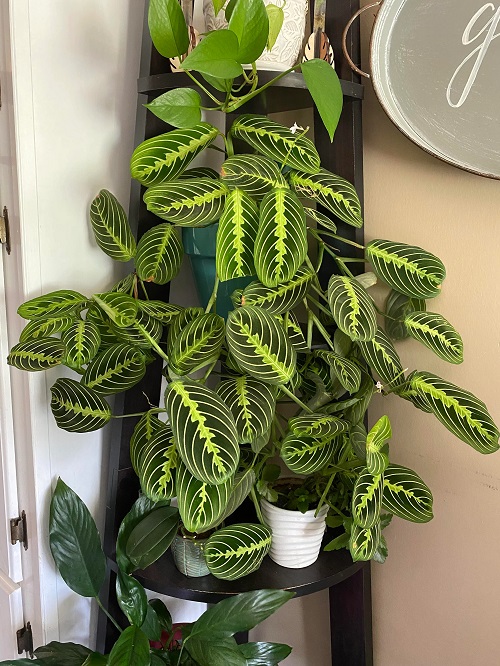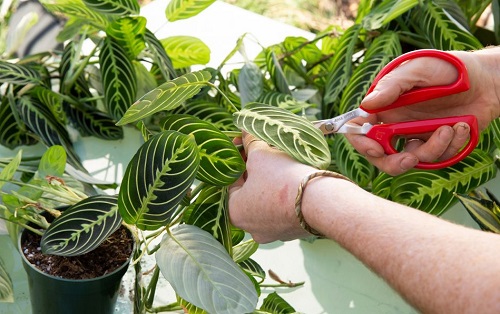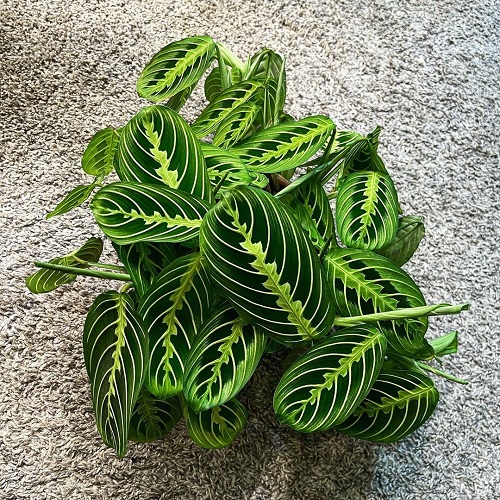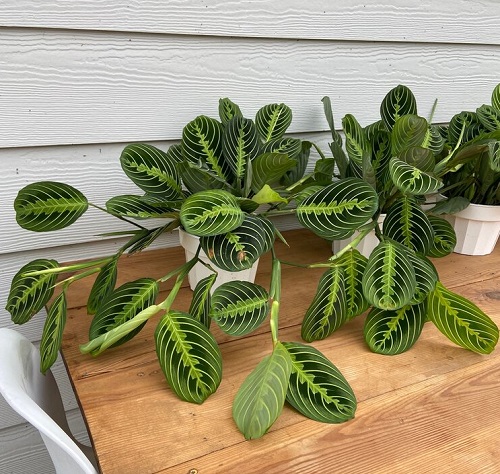Lemon Lime Maranta is a tropical plant species with attractive foliage. Read on and learn about this stunning Prayer Plant Care.

Lemon Lime Maranta is a tropical plant species that is popular among houseplant enthusiasts due to its attractive foliage and ease of care. The plant is known for stunning looks that enhance the beauty of any surrounding as a potted plant and as a garden plant as well!
Botanical Name: Maranta leuconeura ‘Lemon Lime’
Check out the best types of prayer plants here
Lemon Lime Maranta Plant Profile
Lemon Lime Maranta is a tropical plant species that is native to Brazil. It features oval-shaped leaves that are dark green with striking patterns of light green veins. The leaves fold up at night, resembling hands folded in prayer, which is where the plant gets its name.
Its oval leaves are typically green with dark spots and markings on the upper surface and reddish-purple on the undersides.
See How to Grow Philodendron Lemon Lime here
Propagating Lemon Lime Maranta

Here are the easy steps that will help you propagate the Lemon Lime Prayer Plant through division and stem-cutting methods:
Division Method:
- Carefully remove the Lemon Lime Maranta from its pot and shake off excess soil.
- Gently separate the roots and stems into smaller sections. Each section should have at least one healthy stem with leaves and a good root system.
- Use a clean, sharp knife or scissors to cut any damaged or dead roots.
- Plant each section in its own pot with fresh, well-draining soil, making sure the top of the root ball is level with the soil surface.
- Water the newly potted plants thoroughly and place them in a warm, bright location with indirect light.
Stem Cutting Method:
- Select a healthy Lemon Lime Maranta stem with a few leaves and use a clean, sharp knife or scissors to make a clean cut (6-8 inches) just below a node (where a leaf attaches to the stem).
- Remove any leaves on the lower portion of the stem, leaving just a few leaves at the top.
- Dip the cut end of the stem in the rooting hormone to encourage root development.
- Place the cutting in a container of water or in a moist potting mix and keep it in a warm, bright location with indirect light.
- Once roots have developed (usually in 2-4 weeks), transplant the cutting into a pot with fresh, well-draining soil.
Read our article on Propagating Orchids at Home
Lemon Lime Maranta Growing Requirements

Sunlight
Lemon Lime Prayer Plant requires bright, indirect light to thrive. This plant prefers to be kept away from direct sunlight, as it can scorch the leaves.
If Lemon Lime Maranta receives too much light, the leaves may turn yellow and dry out. On the other hand, if the plant is not getting enough light, the leaves may lose their color and vibrancy.
A good location for this plant would be a bright, east-facing spot.
Soil
The soil for Lemon Lime Maranta should be well-draining that is rich in organic matter, and has a slightly acidic soil pH between 5.5 to 6.0.
It is important to avoid using heavy, clayey soil or soil that does not drain well, as this can lead to waterlogged roots and root rot. Use a high-quality potting mix and ensure good drainage by adding perlite or coarse sand.
Water
The Lemon Lime Prayer Plant requires consistently moist soil, but it is important not to overwater as this can lead to root rot. Allow the top inch of the soil to dry out before watering again.
Lemon Lime Maranta may require more frequent watering in warmer months or if placed in a location with higher humidity. It is important to use room-temperature water to avoid shocking the plant.
How Often Do You Water Aloe Vera Plants? Find out here
Temperature
Lemon Lime Prayer Plant thrives in warm conditions and prefers temperatures between 18-24°C (65-75°F).
Protect it from temperatures below 15°C (59°F), and avoid placing it near cold drafts, air conditioning vents, or heaters, as this can cause stress and damage to the leaves.
Humidity
Lemon Lime Maranta requires high humidity levels to thrive. Place the plant in a location with humidity levels between 50-60%. To increase humidity, keep its pot on a tray filled with pebbles and water or mist regularly with room-temperature water.
Check out 10 Ways To Increase Humidity For Houseplants That Work here
Lemon Lime Maranta Plant Care

Fertilizing
Lemon Lime Prayer Plant benefits from regular fertilization during the growing season, which is typically from spring to fall.
Use a balanced, water-soluble fertilizer diluted to half strength every 2-3 weeks.
Over-fertilizing can lead to salt buildup in the soil and damage the plant, so it is important to follow the instructions on the fertilizer package and avoid fertilizing during the winter months.
Pests
Like many houseplants, the Lemon Lime Maranta can be susceptible to pests such as spider mites, mealybugs, and scale insects.
Regular inspection and treatment of any pests are important to maintain a healthy plant.
Pests can be removed by wiping the leaves with a damp cloth or using insecticidal soap. It is important to isolate any infested plants to prevent the spread of pests to other plants.
Read our article on Using Apple Cider Vinegar for Pests
Diseases
Lemon Lime Maranta can be susceptible to root rot and fungal diseases if the soil is too moist and does not drain well.
It is important to ensure good drainage and avoid overwatering. If the plant is showing signs of disease, such as yellowing or wilting leaves, remove them.
Fungal diseases can be treated with a fungicide. Make sure it gets plenty of dappled light and air circulation all day long.


